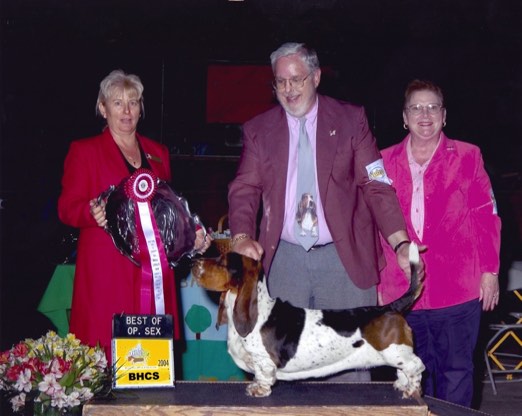
Ch. Vogue’s Woebgon Bonnie Miss
7/21/01 - 9/21/12
The Miracle Girl
The Story of CH. Vogue’s Woebgon Bonnie Miss
By Don Bullock
The more I thought about telling Bonnie’s story the more I realized that I had to start at the beginning. That’s where the miracles started. Sue Shoemaker produced a beautiful bitch named Ellie. I, along with several others, fell in love with her. I told Sue that if she ever bred Ellie that I would love to have a boy out of the litter. My request was answered the next year when she had a litter and Sue gave Pam and I the pick of the boys. Pam and I got “Moose” from the breeding between CH. Shoefly’s Lady Eleanor and CH. Shoefly’s Joshua Bennett. Moose. CH. Shoefly’s Royal Moosehead, was a very big male with plenty of type, just what we wanted to use as a foundation stud.
When he was about a year old, Moose had a tumor removed from his cheek. The biopsy came back as a cancerous lymph node. We decided to treat Moose with chemotherapy. Here is where the first miracle appeared. After a year of chemotherapy we finished his championship and decided to take him off the treatments because they were starting to make him sick. Either our veterinarian got all the cancer when he removed the tumor or the biopsy was wrong because Moose never showed any other signs of cancer.
With cancer, or the possibility of cancer, in his background, other breeders were hesitant of using Moose as a stud. Heather Simonek and her mother Joan had remembered Moose’s mother and were willing to take a chance. They bred Moose to one of their beautiful bitches, Jelly, Vogue’s Black Cherry Jelly. Pam and I wanted a girl from the breeding if there was one. The breeding took and produced three males and one female. I can still remember Joan saying, “Here’s your girl.” as she delivered Bonnie.
Bonnie was entered in the Orange Empire show, in December of 2001, at six months. Pam and I were eager to show off our new girl. While Bonnie didn’t win at the show, she was hit with many of the Southern California breeders. Barbra Dunning, a very long time and respected breeder, called me over after Bonnie was in the ring. She told me that Bonnie was a beautiful bitch. Sue Shoemaker and Bill Nolan both agreed and awarded her Best in Match at the BHCSC and BHCGSD matches respectively. Soon Bonnie’s show career was on a roll. She finished at eleven months with four majors in very stiff Southern California competition in July of 2002. A few months later Bonnie received her first Best of Breed as well as a Group 4 from breeder judge Bill Russell.
Soon afterwards Bonnie became ill. She stopped eating and was very dehydrated. We had no idea what was wrong with her and our regular veterinarian was stumped. Since he didn’t have twenty-four hour care available we took Bonnie to the local emergency hospital for the night. A close friend was one of the technicians at the hospital so we knew she would help look after Bonnie. The next morning we went for a visit. The news was not good. They had to revive Bonnie several times in the night and the tests showed that she had lost all kidney and liver function. Bonnie had acute renal failure and was showing signs that her body's immune system had begun to turn on itself and attack organs and tissues. The veterinarian at the emergency hospital suggested that we take Bonnie to see a specialist in internal medicine, Dr. Ortega, in Ventura. We agreed and transported Bonnie while the arrangements were made for Dr. Ortega to accept Bonnie as a patient.
After an examination, which seemed to take an eternity, Dr. Ortega confirmed that Bonnie was suffering from acute renal failure and said that she had already started to treat Bonnie. Her prognosis wasn’t good, but Dr. Ortega thought Bonnie could be saved. At the time we still weren’t sure of the cause of the problem. Because Dr. Ortega could not rule out Leptospirosis as a cause, Bonnie was put in an isolation cage, hooked up to all kinds of monitors and administered fluids. She seemed to at least be stable, but Dr. Ortega warned us that she could turn abruptly for the worse at any time.
A couple of days later, while teaching in my classroom, I received a call from Dr. Ortega. She gave me a quick update on Bonnie’s condition and asked of I had considered hemodialysis as a treatment for her. I had no idea that they did such a thing with dogs. She said that U.C. Davis had a companion animal hemodialysis program at the U.C. Davis campus and one near San Diego. I told Dr. Ortega I was concerned about the cost. Dr. Ortega suggested that she check on the cost and availability of treatment and call me back. First, she wanted to know if we wanted to go to Davis or San Diego. Since San Diego was closer I had her check there first. It seemed like forever before she called back. The program in San Diego had an opening and Dr. Ortega thought if the hemodialysis treatments could clean out Bonnie’s kidneys perhaps the length of the treatment would be lessened and offset the cost of the treatments. By now we and Dr. Ortega had decided that an allergic reaction to a sulfa-based antibiotic must have been the reason for the kidney failure but we weren’t sure. Dr. Ortega advised the UCVMC – San Diego Hemodialysis Service that we would be bringing Bonnie as soon as we could.
First, we had to get two substitute teachers to take over our two classrooms. Once they arrived, we drove up to get Bonnie in Ventura. They packed Bonnie in our van with an IV attached to her and we headed to San Diego. As soon as we reached the hospital, they were there to meet us. Dr. Fischer and her nurse, Paula Thomas, were both surprised to see how strong Bonnie was after all she had gone through. Dr. Fischer predicted that Bonnie would require numerous treatments to clean out her kidney and that there was the possibility that her kidney may never fully recover. We told her that we wanted to go through with the treatments. While Dr. Fischer got us all signed in to her unit and the attached veterinary hospital where Bonnie would be cared for when she wasn’t receiving treatments, Nurse Paula was getting Bonnie prepared for her first hemodialysis treatment. By the time we left for home, they had already started Bonnie’s first treatment. During the prep work on Bonnie routine tests were done. When Dr. Fischer called us at home to tell us that the first treatment was complete she gave us the news that a test came back positive for antifreeze. She further explained what I had feared; antifreeze poisoning is almost 100% fatal unless treated in the first eight hours.
Pam and I were devastated at this news. We researched products containing antifreeze to try to determine where Bonnie could have come in contact with it. I soon discovered that the number of products containing antifreeze (ethylene glycol) is seemingly endless. It’s even found in ballpoint ink pens, toothpaste and just about every household cleaner. Through the Internet I discovered that one-half teaspoon of anti-freeze per pound of dog body weight is enough to cause the clinical signs of poisoning. This information was later confirmed by one of Bonnie’s attending doctors. We couldn’t find anything around the house where Bonnie could have gotten that much antifreeze.
Due to the possibility of antifreeze poisoning Dr. Fischer followed her regimen for antifreeze poisoning and put Bonnie on longer hemodialysis treatments than if she had a drug reaction. Since Dr. Fischer had to be in Davis to speak at a conference most of our communication for the next few days was from Nurse Paula and the attending doctor from the veterinary hospital. Each day they were both able to report good progress, but reminded us that we could still lose Bonnie at any time. Dr. Fischer and the director of the Davis hemodialysis program both agreed that Bonnie had less than a 50/50 chance of living when she arrived at their facility.
During most of this time Bonnie was in the hospital Pam and I were stuck at school. It’s almost impossible for us to take time off from teaching and it gave us something to concentrate on other than Bonnie. We were able to go down one day to visit her, but I’m sure she really didn’t recognize us. A couple days after Bonnie’s third treatment, on my way to the office during recess, I found a strange message on my cell phone. Evidently the call didn’t go through from the hemodialysis unit and they left a message. According to the message they wanted me to call back to finalize our bill. I had no idea if Bonnie was alive or dead. Frantically, I called. The news was fantastic. According to the blood tests Bonnie had full kidney function and the liver was improving rapidly. They were discharging Bonnie from further hemodialysis treatments. After all the tests were done, including a special test that had to be sent to the U.C. Davis lab, were completed, Dr. Fischer was able to rule out antifreeze as a cause and that the most likely cause was a reaction to the sulfa-based antibiotic, Primor. Both Dr. Fischer and Dr. Larry Cowgill, the one who developed the hemodialysis process for small animals at U.C. Davis, felt that Bonnie’s full recovery was a miracle. They called her the “miracle girl.” Bonnie, however, was still suffering from many of the lateral effects of the acute renal failure but most of them were improving as well.
Now we just needed to get her to eat, drink and have full urinary function before she could be released from the veterinary hospital. That should be easy we thought. Bonnie has always been a good eater. Unfortunately that was not the case. The veterinary hospital staff tried every trick they could to get Bonnie to eat with no success, but they were able to get her to drink some water. We were invited down over the weekend to see if our presence would help. They suggested that we bring some freshly cooked chicken and a few other pieces of Bonnie’s favorite food. Nothing worked. Bonnie was pathetic. We did, however, have a breakthrough with her urinary tract. Somehow she had pulled her catheter loose and made a couple of big puddles on the floor. While Bonnie was embarrassed, we, and the medical staff were elated. Now, the lack of eating was the only thing holding back Bonnie’s progress.
The hospital bills were mounting. Twenty-four hour care in a facility like the one she was in is very expensive. We talked the veterinarians into letting us take Bonnie home in hopes that being home might stimulate her eating.
Upon getting Bonnie home the tremendous responsibility of getting her to eat became overwhelming. It seems like I talked with every basset hound breeder and owner in Southern California by phone or email, as well as the basset hound owners on the Daily Drool online group, seeking ideas for ways and food suggestions to get Bonnie to eat. None of the suggestions seemed to work. Sue Shoemaker had suggested that we force feed Bonnie using the Eukanuba Weaning Diet food that is high in nutrition and already ground up. Pam made balls of the food by mixing it with water. Getting them down Bonnie’s throat wasn’t easy, but she kept the food down once I got it in. After reading the label I figured there was no way that I would be able to force enough into Bonnie to keep her going, much less gain any of the weight she had lost. In desperation I called Sue again. She encouraged me to keep trying to get as much food into Bonnie as I could. In the meantime Pam continued fixing and trying all the foods that people suggested, even cooking liver. We still couldn’t get Bonnie to eat on her own. This seemed to go on for weeks. I’ve lost track now as to how long we went through this routine. One afternoon we got our first breakthrough. Bonnie acted interested in something that Pam fixed and actually took some small bites. It was still several days before she would eat on a regular basis. That weekend we took Bonnie out for a visit at a BHCSC match. Everyone was amazed to see how well she looked. At the match Jo NewMyer, a prominent Southern California basset hound breeder, paid Bonnie a great compliment when she explained to another breeder that no other basset hound she knew would have survived what Bonnie had gone through.
Finally, Bonnie was back to normal. Except for the weight she had lost, she didn’t seem to have any lasting affects from the ordeal. We did regular blood tests to make sure she didn’t have a relapse. It took a long time for Bonnie to gain back the weight and stamina needed for the show ring. I was determined to continue showing her because she is such a beautiful basset so I continued working with her to build up her stamina while Pam worked on her weight.
It wasn’t until March of 2004 that Bonnie was finally back in great shape. She won an Award of Merit at the Basset Hound Club of Southern California specialty show as well as Best of Breed at two all-breed shows that month. Bonnie went on the get Best Opposite Sex at the Sacramento Basset Hound Club show and continued to win several more Best of Breed awards at all-breed shows. By summer, Bonnie was in the top twenty-five basset hounds for the year and qualified for the AKC/Eukanuba National Championship show as well. Now I was faced with the task of keeping her there. Since Heather Simonek, her breeder, was committed to showing another basset in Best in Breed competition; I was the one who had to keep Bonnie in the shows. She stayed around number eighteen all summer and with Heather’s help at a few shows at the end of summer she stayed there to qualify for the AKC/Eukanuba National Championship show.
In the fall of 2004 Bonnie developed a very unusual case of pyometra or endometritis. It took almost two months to diagnose and treat Bonnie before she was back to normal. Our regular veterinarian had wanted to spay her but Dr. Terry Johnson was successful in treating Bonnie, another of the miracles in her life. Even with all this time off from showing Bonnie finished 2004 at number thirteen for the breed. Heather and I took her to Tampa for the AKC/Eukanuba Championship show. No, Bonnie didn’t win anything, but she was considered by the judge for Best Bred by Exhibitor.
In 2005 we started thinking of breeding Bonnie. We tried having semen shipped in from out of state for breeding. After a second attempt to use semen shipped in from another state, we decided to breed Bonnie to Me-Don’s Ol’ South’s Top Priority who was living with the Nolan family here in Southern California. Dr. Johnson performed a surgical implant of fresh semen and we followed up with two trans-cervical artificial inseminations. During the surgery Dr. Johnson discovered that Bonnie’s uterus had a lot of small cysts. She had seen this before in other bitches and knew how to remove them. This may be what was causing the problems in our previous attempts to breed Bonnie as well as part of the cause of her difficult case of pyometra. The breeding was successful. Dr. Dana Bleifer performed a c-section June 1, 2006. Due to Bonnie’s medical history, we felt that this was our best option. It turned out to be a good choice because Dr. Bleifer felt that one of the puppies would have never made it in a natural whelp. We are currently happily raising five puppies. Bonnie is doing very well and has become a super mother, which tops off the miracles in her life to this point.
We don’t know what lies ahead for Bonnie. Fortunately she is in excellent health. Our hope is that this will continue, but we will keep monitoring her closely for any signs of health problems. The decision on an additional breeding hasn’t been made. It’s too soon for that. As for a show career, we are looking forward to entering Bonnie in specialty shows as a veteran. She is still a beautiful basset. More importantly Bonnie has the sweetest temperament of any basset hound that I know. Pam and I are looking forward to many more years sharing the couch and our bed with Bonnie.
Addendum
Three of Bonnie’s five puppies finished their AKC Championships. Jack (Ch. Vogue’s Woebgon Black Jack) finished first. He finished in one show weekend in Arizona starting with his first points for a major at a basset hound Specialty show on Thursday, March 1st. and completing the requirements for his AKC Championship on Sunday, March 4th. Four days and four majors. Snowy (Ch. Woebgon’s Snow White) finished second. She finished her Championship at the Western Hound Classic. Last, but not least, was Tommy Bahama (Ch. Woebgon’s Tommy Bahama). Tommy definitely lived up to his name by always doing something different at every show to keep Don on his toes.
Bonnie continued living several more years after this article was published. She had an excellent record as a veteran in basset hound specialty shows. Her last win was at the Greater San Diego Basset Hound Club Specialty on May 28, 2010 where Barbara Dunning was the judge for their Sweepstakes. Barbara still loved Bonnie and awarded her Best in Veteran Sweepstakes.
Bonnie moved with us from our home in Simi Valley, California to our current home. A few years after moving here Bonnie was diagnosed with a growth on her spleen. That was in October of 2011. Bonnie lived almost a year longer than the vet expected after that discovery and subsequent diagnosis. During that year she became a grandmother of a second litter from Snow White. She was truly our “Miracle Girl” to the very end. All of us at Woebgon Bassets miss our Bonnie Miss. There is an empty spot on our bed where she used to sleep.
The pictures below were taken on three of several trips down to see Bonnie at the hospital. On the first of these trips Bonnie accidentally pulled out her catheter. As a result she made two very large puddles on the floor proving that she could urinate on her own. This was a huge breakthrough in her recovery. The pictures toward the end were taken on the day she got to come home with us. While she still wasn’t eating we, along with doctors, felt that going home might be the only way to get her to eat. As mentioned in the article above it took a lot of effort and time for Bonnie to fully recover and start eating on her own. Dr. Fischer and Nurse Polly, shown in some pictures here, are both fantastic. We owed Bonnie’s life to them and the other vets who helped save her life.
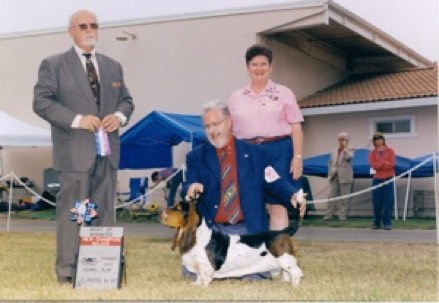
Bonnie's Final Win for her Championship
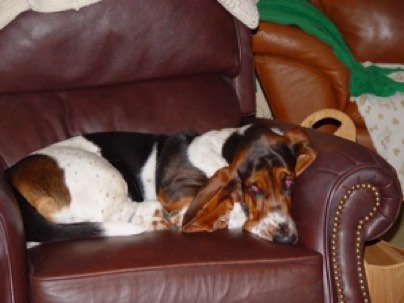
Bonnie, on Don’s chair just before she became ill. This chair was her favorite place in the house other than our bed.
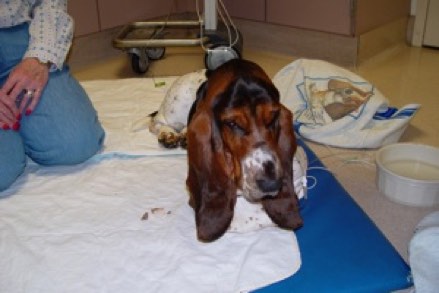
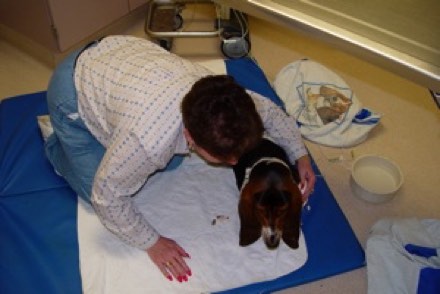
Bonnie was pretty pathetic when we visited her in the hospital. She had no idea who we were and was very unsure of what was going on.
Pam trying to get Bonnie to recognize her voice. There was very little response.
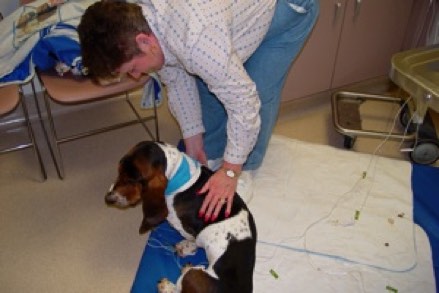
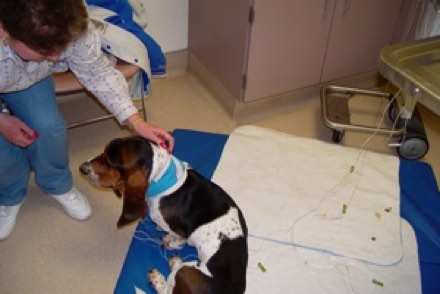
Pam continued to work with Bonnie trying to get any sign that she recognized her.
Pam and Bonnie still working on making a connection.
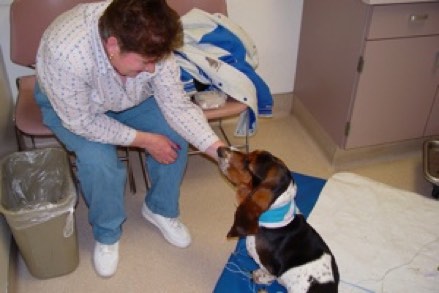
Pam and Bonnie and the first sign of any recognition we were even there at all. No signs of emotion.
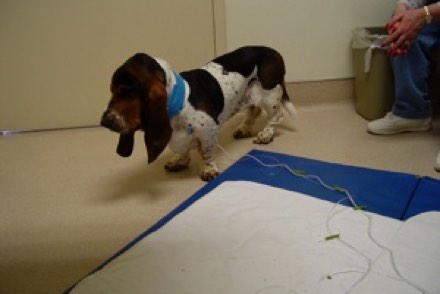
This is when we think that Bonnie’s catheter came out.
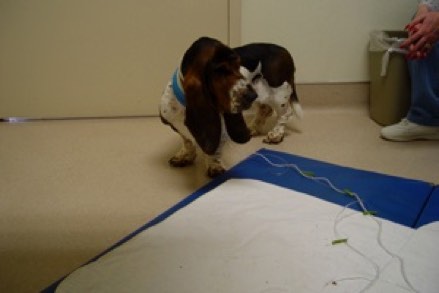
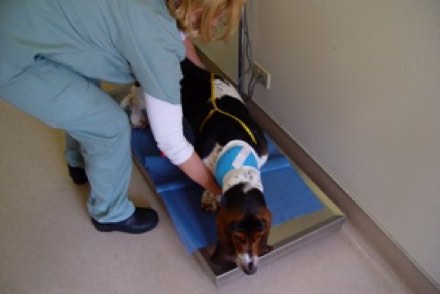
We let her wander around the room. Later we took her for a walk down a hall to give her a little exercise. That’s where she made her two bug puddles on the floor. Bonnie was obviously embarrassed over the puddles. That was our first sigh of any normality and possible recovery.
One of the nurses trying to get her weight. She was pathetically thin and they had to weigh her very often.
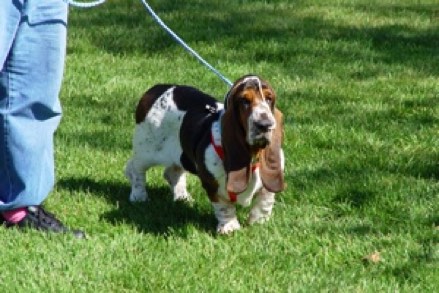
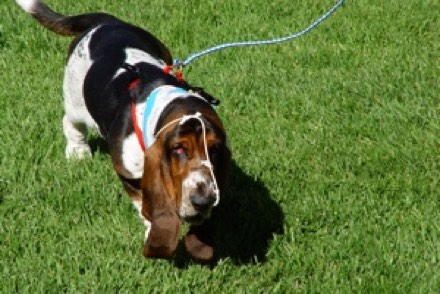
On the next visit we took her outside hoping that the change in surroundings would encourage her to eat for us.
She seemed to like the walk. Because of all the tubes and the sutures where the dialysis machine was hooked up to the blood vessels in her neck, we walked Bonnie on a harness. On her last day Bonnie donated a variety of harnesses to the Dialysis Unit for other dogs to use. for their walks.
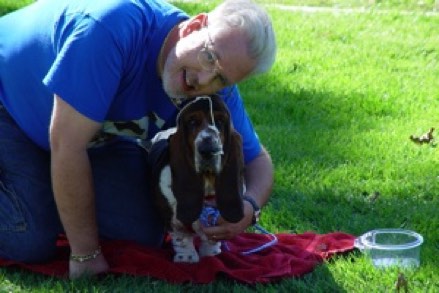
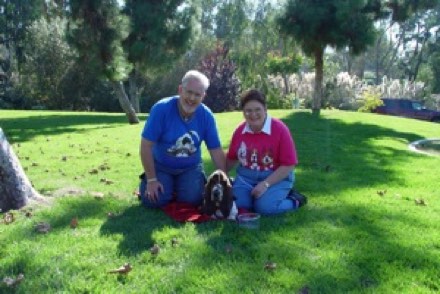
Don with Bonnie. Yes, he usually takes the pictures.
Someone walking by offered to take this picture of the three of us. Bonnie was starting to recognize us.
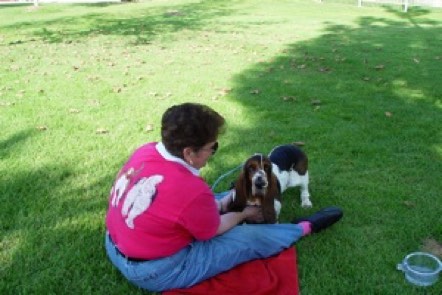
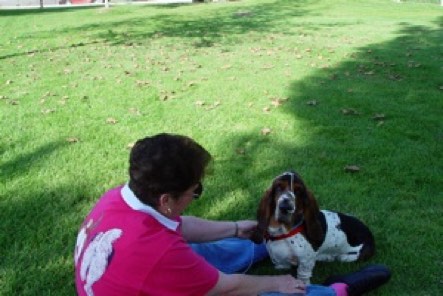
Pam with Bonnie. We even brought her chicken and some other food from a local restaurant hoping that Bonnie would eat something.
Pam with Bonnie, still working on getting her to recognize us.
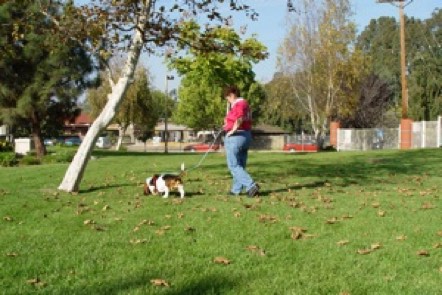
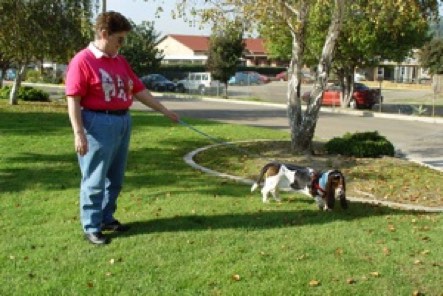
Pam taking a walk with Bonnie. Bonnie got her tail up on part of the walk but for the most part it was down.
Pam taking a walk with Bonnie getting her some needed exercise hoping it would stir up an appetite.
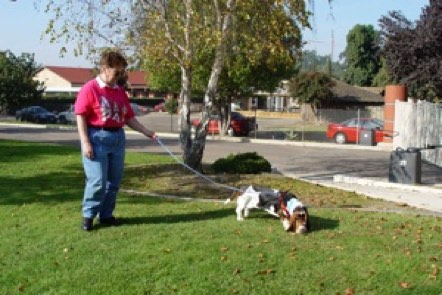
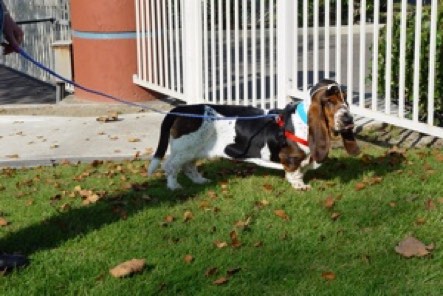
Pam taking a walk with Bonnie. Fortunately it was a very nice day to be outside for a walk.
Pam taking a walk with Bonnie.
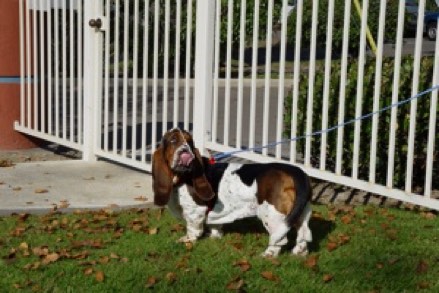
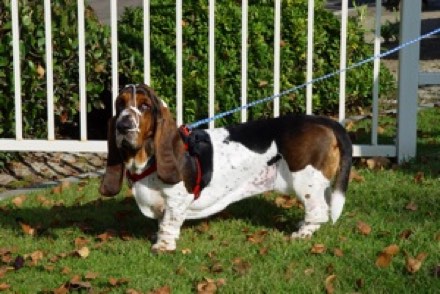
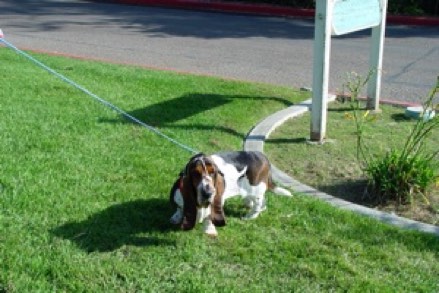
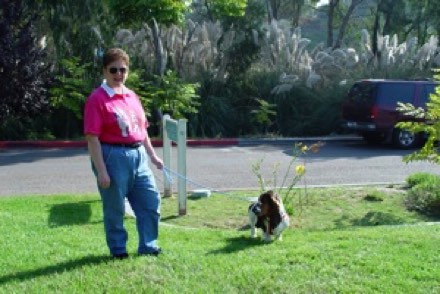
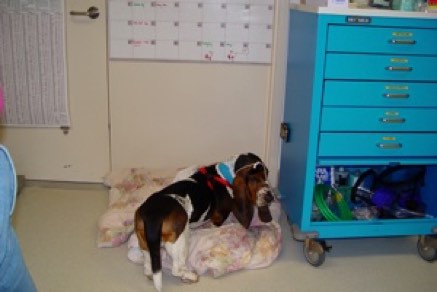
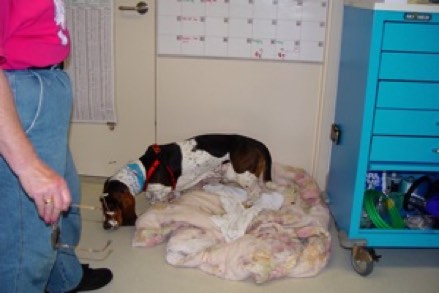
This is how we found Bonnie on the day we decided to take her home. Though she still wasn’t eating we thought that perhaps being at home with us would be better than staying at the hospital. As you can imagine the bills were getting very high by now and we felt she wasn’t improving any in the hospital.
She was still pretty pathetic but she did easily recognize us and was very happy to see us. We got a few tail wags but it still was mostly down on this visit too. That was very encouraging for all of us.
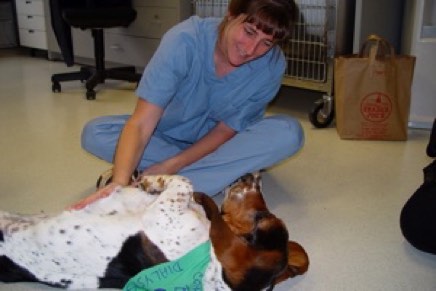
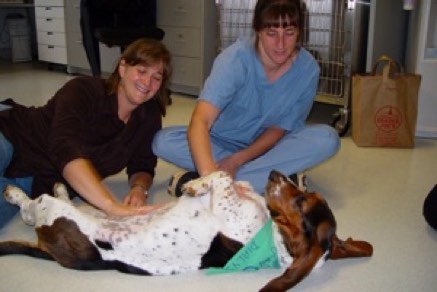
Nurse Paula who cared for her. Bonnie is wearing a scarf made from a surgical gown. It, along with the messages written on it, signifies Bonnie’s “graduation” from dialysis treatments and full recovery.
Dr. Fischer and nurse Paula, two wonderful people who are truly talented and love what they do.
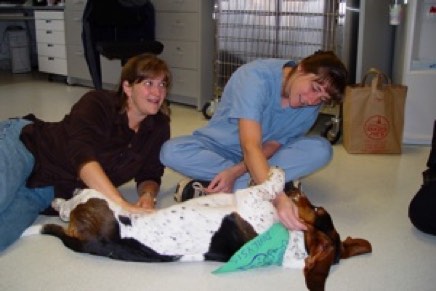
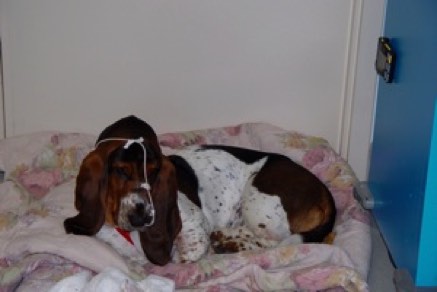
Dr. Fischer and nurse Paula. I think that the two of them were as happy as we were at Bonnie’s success. Most of their patients never recover like Bonnie did because their need for dialysis is ongoing.
Bonnie liked the bed they made for her in the dialysis room. She was in this room whenever there were people around. Otherwise Bonnie was in her crate over in the hospital section of the facility.
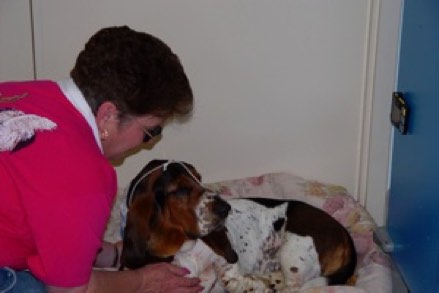
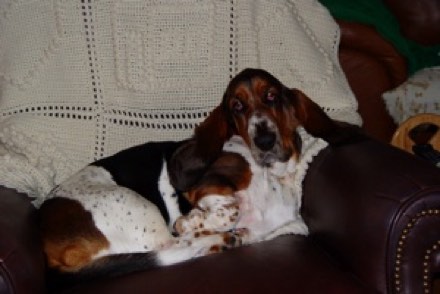
Pam with Bonnie just before they took the tubes out so that we could leave for home.
Bonnie, back on Don’s chair after fully recovering from her ordeal.
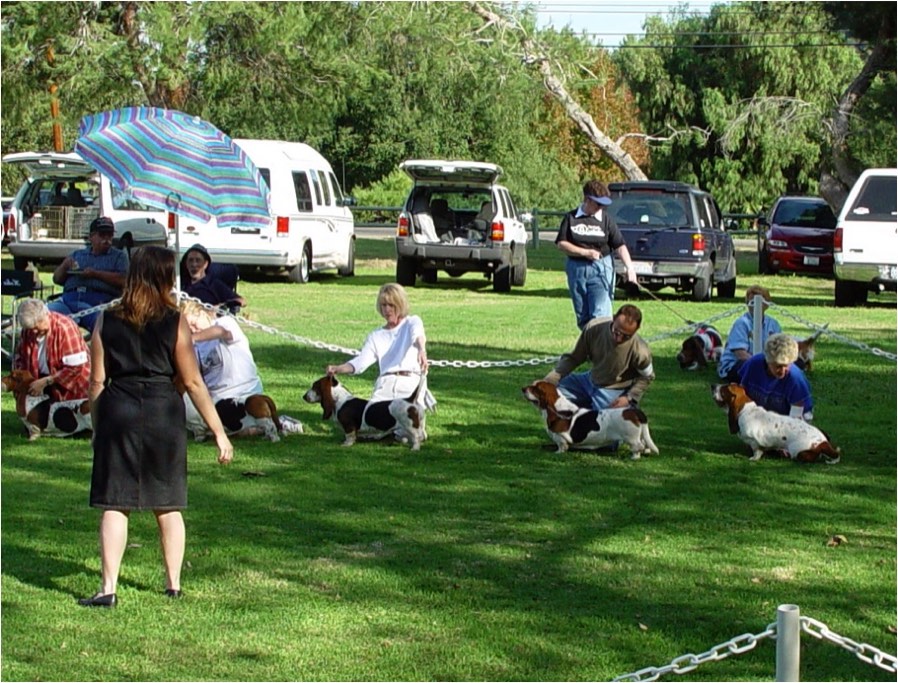
The weekend after we brought Bonnie home we took her to a BHCSC Puppy Match where Heather was judging. Pam and Bonnie can be seen in the background. While Bonnie seemed to like seeing everyone and being out of the house she was still far from being fully recovered. Everyone was glad to see her and were astounded at her progress. That's when basset hound breeder Jo Newmeyer told several people at the match, "No other basset would survive what she's gone through."
This website was created and is maintained by Don Bullock.
He can be reached at basithd@yahoo.com
All material on this website is copyright by Donald W. Bullock
All rights are reserved
